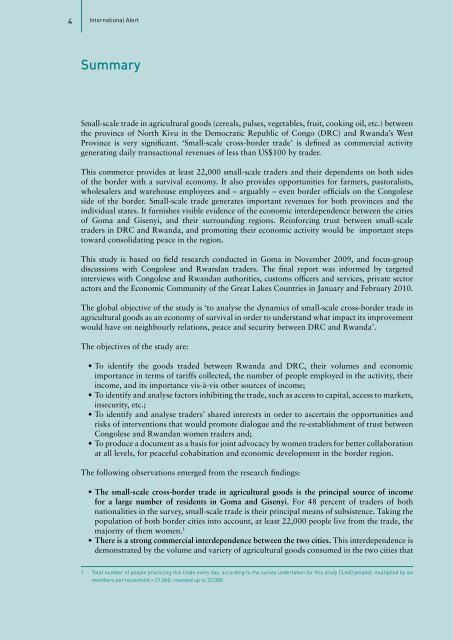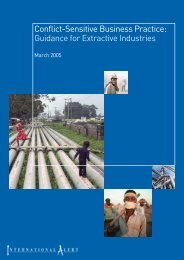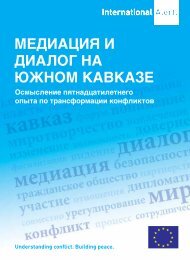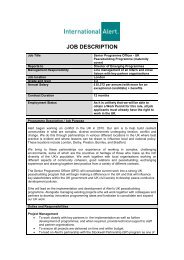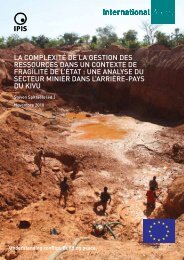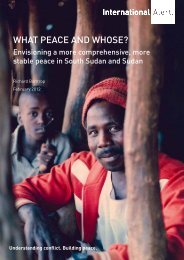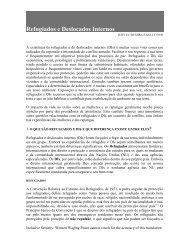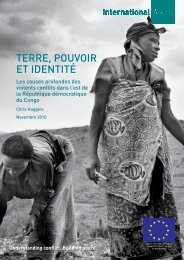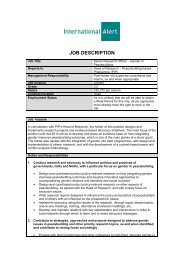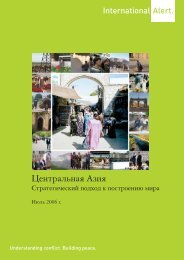4 <strong>International</strong> <strong>Alert</strong>SummarySmall-scale trade in agricultural goods (cereals, pulses, vegetables, fruit, cooking oil, etc.) betweenthe province of North Kivu in the Democratic Republic of Congo (DRC) and Rwanda’s WestProvince is very significant. ‘Small-scale cross-border trade’ is defined as commercial activitygenerating daily transactional revenues of less than US$100 by trader.This commerce provides at least 22,000 small-scale traders and their dependents on both sidesof the border with a survival economy. It also provides opportunities for farmers, pastoralists,wholesalers and warehouse employees and – arguably – even border officials on the Congoleseside of the border. Small-scale trade generates important revenues for both provinces and theindividual states. It furnishes visible evidence of the economic interdependence between the citiesof Goma and Gisenyi, and their surrounding regions. Reinforcing trust between small-scaletraders in DRC and Rwanda, and promoting their economic activity would be important stepstoward consolidating peace in the region.This study is based on field research conducted in Goma in November 2009, and focus-groupdiscussions with Congolese and Rwandan traders. <strong>The</strong> final report was informed by targetedinterviews with Congolese and Rwandan authorities, customs officers and services, private sectoractors and the Economic Community of the Great Lakes Countries in January and February 2010.<strong>The</strong> global objective of the study is ‘to analyse the dynamics of small-scale cross-border trade inagricultural goods as an economy of survival in order to understand what impact its improvementwould have on neighbourly relations, peace and security between DRC and Rwanda’.<strong>The</strong> objectives of the study are:• To identify the goods traded between Rwanda and DRC, their volumes and economicimportance in terms of tariffs collected, the number of people employed in the activity, theirincome, and its importance vis-à-vis other sources of income;• To identify and analyse factors inhibiting the trade, such as access to capital, access to markets,insecurity, etc.;• To identify and analyse traders’ shared interests in order to ascertain the opportunities andrisks of interventions that would promote dialogue and the re-establishment of trust betweenCongolese and Rwandan women traders and;• To produce a document as a basis for joint advocacy by women traders for better collaborationat all levels, for peaceful cohabitation and economic development in the border region.<strong>The</strong> following observations emerged from the research findings:• <strong>The</strong> small-scale cross-border trade in agricultural goods is the principal source of incomefor a large number of residents in Goma and Gisenyi. For 48 percent of traders of bothnationalities in the survey, small-scale trade is their principal means of subsistence. Taking thepopulation of both border cities into account, at least 22,000 people live from the trade, themajority of them women. 1• <strong>The</strong>re is a strong commercial interdependence between the two cities. This interdependence isdemonstrated by the volume and variety of agricultural goods consumed in the two cities that1 Total number of people practicing this trade every day, according to the survey undertaken for this study (3,640 people), multiplied by sixmembers per household = 21,840; rounded up to 22,000.
<strong>The</strong> Crossing5come from across the border. In times of insecurity in Eastern DRC, the flow of goods fromthe North Kivu province in Rwanda is blocked and prices rise sharply.• <strong>The</strong> lack of systemic consistency in taxation in Rwanda and DRC creates serious difficultiesfor small-scale business. In Rwanda, the ‘unique service’ system is in force. Export taxes areset at zero, but tariffs on imported agricultural goods are steep. In DRC, there are numerouscustom services, only some of which are authorised to work at the border and/or collect taxes.At the Goma border <strong>crossing</strong>, 90 percent of traders pay ‘informal’ tariffs to several stateactors, often accompanied by physical harassment. 2• Rwandan traders have a weaker capital base than their Congolese counterparts. <strong>The</strong> capital 3used by traders originates mainly from household resources (69 percent) or money loanedby other family members or friends (22 percent). <strong>The</strong> Rwandan small-scale trader has anaverage start-up capital as low as US$13.90, compared to the Congolese trader’s US$19.50,irrespective of gender.• Competition and distrust characterise relations between women traders from both cities.Congolese women traders are vexed by the competition created by the Rwandan women’spractice of itinerant trading. Rwandan women claim they are ‘chased from the market’ bytheir Congolese competitors, that they do not have their own markets, and that they areharassed by Congolese customs services when <strong>crossing</strong> the border and by other persons inGoma. However, the study shows that women traders from both countries have interests incommon, including the creation of a one-stop border point, the reduction of harassment atthe border and the establishment of dialogue to seek solutions to their mutual problems.SOME RECOMMENDATIONS• <strong>The</strong> authorities of North Kivu and West provinces should establish a permanent, tax-freeborder market for agricultural produce sold by small-scale Rwandan and Congolese traders,and organise regular border fairs where goods from both sides can be displayed for sale.• <strong>The</strong> DRC and Rwandan authorities should liberalise the small-scale trade in agriculturalgoods by implementing the Common Market for Eastern and Southern Africa (COMESA)‘Simplified Commerce Regime’ (RECOS), and the Economic Community of the Great LakesCommunity (ECGLC) ‘Protocol for the Liberalisation of the Trade in Basic Goods’.• Goma and Gisenyi municipal authorities must reinforce the partnership between them throughregular dialogues aimed at establishing strategies and agreements that facilitate cross-bordertransactions, including the small-scale trade in agricultural goods.• Rwanda and DRC should standardise cross-border tariffs and open a one-stop border point onthe Goma <strong>crossing</strong>, including associated improvements such as training and paying professionalstaff, computerising trans-border movements, and other streamlining measures, etc.• Over the long term, DRC and Rwanda should establish a one-stop border post allowing forjoint customs inspection by Congolese and Rwandan officials, reducing delays and informallevies on traders. 4• Goma authorities should enforce a zero-tolerance policy against the harassment of traders bystate officials and semi-official actors, such as the ‘Maibobo’, ‘Rasta’ and ‘Kajoriti’.• Associations of Congolese and Rwandan traders, linked by common lines of business, shouldbe encouraged with a view to harmonising their activities, gaining joint access to credit andseeking solutions to existing problems.• <strong>The</strong> re-establishment of partnerships between small-scale traders’ associations from Gisenyiand Goma in order to promote direct sales.2 <strong>The</strong> term, ‘informal tax’, is used to describe the payment by traders of small amounts of money to state actors without legal basis in orderto facilitate their <strong>crossing</strong> of the border.3 <strong>The</strong> term, ‘capital’, is used to denote a collection of assets or cash before interest and profit are extracted. It also describes the valuationof inputs (primary materials, services carried out, fixed equipment, etc.) involved in the production of goods.4 This system is currently in use on the Rwanda-Uganda border at Katuna.


